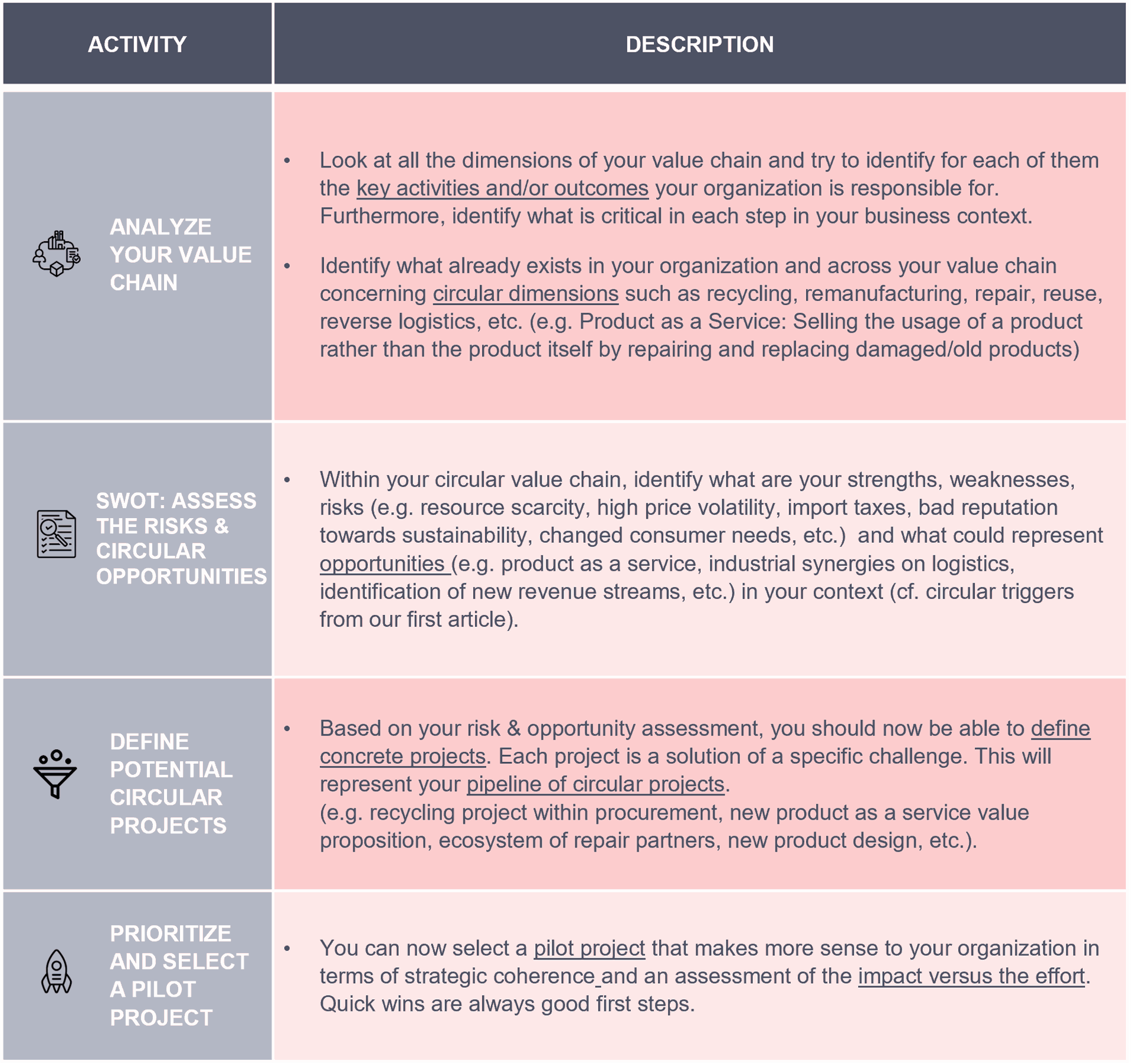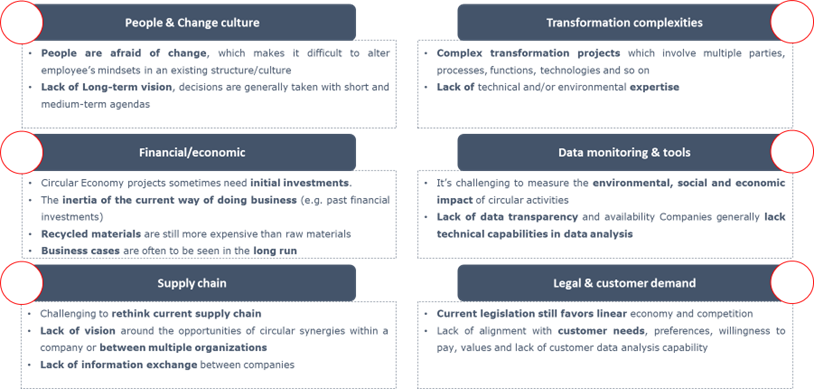In our first circular article, we explained what circular economy means and which kind of triggers could motivate organizations to start a circular transformation.
This follow-up article describes ngage’s point of view on how an organization can approach a circular transformation, while highlighting key challenges and best practices to consider along the way.
You will discover that Circular Economy often implies more than an incremental approach but often deals with a business model transformation impacting multiple dimensions of your organization (operations, HR, etc.).
HOW TO START A CIRCULAR TRANSFORMATION?
There is no one-size-fits-all approach that
works for each circular transformation journey.
Like any other transformation, the way of working always need to be adapted to
the context of the organization. However, we recommend having a structured approach
to minimize risks and always consider the organization’s needs. The mindset
being to start small while thinking big.
We suggest to follow this 5 phases model as an inspiration for a circular transformation, which can be tailored accordingly.

1. QUESTION YOUR WHY
Before committing to a circular journey, a first logical step should be to ask yourself whether the context of your organization allows for opportunities in this field.
To come back to our first article, you will need to ask yourself the following questions:
- What does Circular Economy mean for my organization?
- Do I have triggers?
- Is it something for my organization?
- What are the expected benefits?
If you remember, opportunities can vary from financial advantages to an increase in business resilience. Other triggers can be related to a company’s value proposition and/or its sense of responsibility.
Each of these triggers, described in more detail in the first article, need to be assessed with both the context of your organization and your industry.
What are my enablers?
In general, there are facilitators/enablers that will support you in achieving your expected benefits. Certain opportunities can exist in your organization, but you also need to be able to act upon them.
As circular opportunities often go beyond the activities of just one organization, efficient collaboration with partners and suppliers is a first important facilitator to take advantage of certain triggers.
Access to relevant technologies is another example. Depending on your organization and industry, circular economy might bring along a certain level of technical complexity. This can be met by your company or other players in the market. Exposing technical hurdles and anticipating how technology can help to overcome them, avoids unpleasant discoveries along the way.
2. IDENTIFY OPPORTUNITIES
If your organization identified relevant triggers and enablers, it is now time to take the plunge into the vast circular economy ocean. This is the part where most organizations struggle. Facing the complexity and the richness of circular economy, it is difficult to identify the right project to start with that will put you on the path to a successful circular transition.
Our advice here would be not to jump too quickly in the first opportunity you can think of. Instead, take the time to analyse your current situation, your ecosystem, and your value chain. This will help you to have a better understanding of the existing opportunities and challenges and to select the one that has the most potential to answer to your objective.
Find here an approach to be able to select the right circular project to start with:

3. TEST WITH A FIRST PROJECT
Entering the implementation phase, we recommend to always start small whether it is with a pre-identified quick win, or with a pilot version of a bigger ambition. Some companies more mature on the circular topic might obviously go for a larger transformation approach.
The goal of this phase is to learn and test that circular model can work in your organization, while serving as a proof-of-concept internally and externally. This pilot phase helps to validate assumptions. Sometimes several trials are needed.
Every project is different, but some key tips can help your organization in the execution of this test-phase:
- Identify your current capabilities and what is lacking to execute your circular project. You might have to look for external help, partnerships or consider developing the idea first outside the organization to make it work.
- Define KPI’s to measure the success of your pilot project and measure them regularly.
- Include agility in the way you execute your project: develop and test your solution step-by-step with regular feedback loops
- Don’t underestimate the need for change management, set a communication plan and don’t forget to celebrate small successes along the way.
4. LEARN & DEFINE AMBITION
When arrived at the end of your pilot project, you should take the time to reflect on what you have done. Do the results match with the initial goals? Are expectations met? What did work in your project and outcome and what did not? Does circular economy make sense in practice for my organization looking at people, planet and prosperity perspectives?
In this phase we recommend to take a step back to approach circular economy on a broader perspective.
Based on learnings from your first pilot project and a strategic/macroeconomic analysis of your organization, you can finally define your long-term circular ambition. Generally speaking, this will also require to re-think your organization at a higher level, by building a sustainable development plan, in which circular economy could occupy a central spot. Your circular project pipeline can also be finetuned and re-assessed to define a broader circular roadmap aligned with a long-term ambition.
Organization can at this point of time choose for three scenarios:
- Choose to not prioritize circular economy and wait for an opportunity later
- Slowly deploy circular economy by implementing small scale circular projects while minimizing risks
- Embed and anchor circular economy throughout all your organization’s business model
5. SCALE & ANCHOR
If your ambition is to embed circularity at all levels of your organization, you will need to include this in a more global transformation program, based on your circular roadmap.
Like any other transformation programs to scale and anchor, we recommend to:
- Define the transformation vision towards your circulation ambition and question how far your organization wants to change its business model
- Build and maintain a structured program/project portfolio with an appropriate governance
- Make sure your transformation program and projects are well aligned with your operating model to maximize the anchoring of circularity into your day-to-day processes
- Get the top leadership involved and build a team of ambassadors that will carry out various projects and promote the benefits of circular economy throughout your organization and the rest of your stakeholders.
- Invest in change management, communication, people training, recruiting and potentially in centers of expertise to further develop your circular capabilities
- Measure the circular transformation progress through circularity indicators
- Get inspired by organizations succeeding in their circular transformation which managed to (re)integrate a startup, innovation and test & learn culture, while breaking silos and investing in multifunctional teams
- Map and build an ecosystem of stakeholders and partners that have the potential to support you in your endeavor.
- Investigate and activate the different sources of financing internally or externally (via public support or partnerships) to maximize the scale of your transformation
A great attention should also be paid to the typical challenges and barriers related to the development or acceleration of circular economy projects.
WHAT ARE THE TYPICAL CHALLENGES?
It shouldn’t be a surprise that you might encounter certain challenges and/or barriers related to a circular transformation project.
Circular transformation is not an easy journey and contains several barriers along the way (Fig. 1). The most critical being change, financial, legal, data monitoring or transformation challenges. Organizations that are able to identify and address those challenges upfront will have more chance to succeed in their transformation.

(Figure 1)
We believe circular economy is a real business model transformation and it requires to include transversal elements impacting people, business, structure and often culture.
Recognizing
your organization in some of these challenges?
Do you need an external perspective to properly address your circular
transformation journey?
Do you want to ngage in circularity?
ngage can surely support you in your transformation journey while making sure barriers are identified and addressed appropriately.
Discover how our tangible approaches, transformational capabilities (Operational Excellence, Human Transformation, Business Technology, Finance Transformation and Customer Experience) and our #excellence-driven, #human-centered and #enjoyment-minded values can support you in your circular transformation while considering your company’s culture and business priorities.
IT’S TIME TO ACT
As explained previously, linear economy is not a viable and sustainable model anymore and, among other solutions, a circular transition is needed to preserve natural resources, reduce our wastes and polluting emissions.
We believe the organization themselves through their employees or leaders have the power to change their model and use circular economy in their best interest for their long-term prosperity as well. We explained in this article a simple approach to start and anchor your circular transformation. This can obviously be leveraged thanks to a favourable political, legal and fiscal context as well as a change in the customer behaviours.
So…what to do now? Any organization can think and evaluate the potential of circular economy within their business model and value chain. It’s now time to act, dare to start!